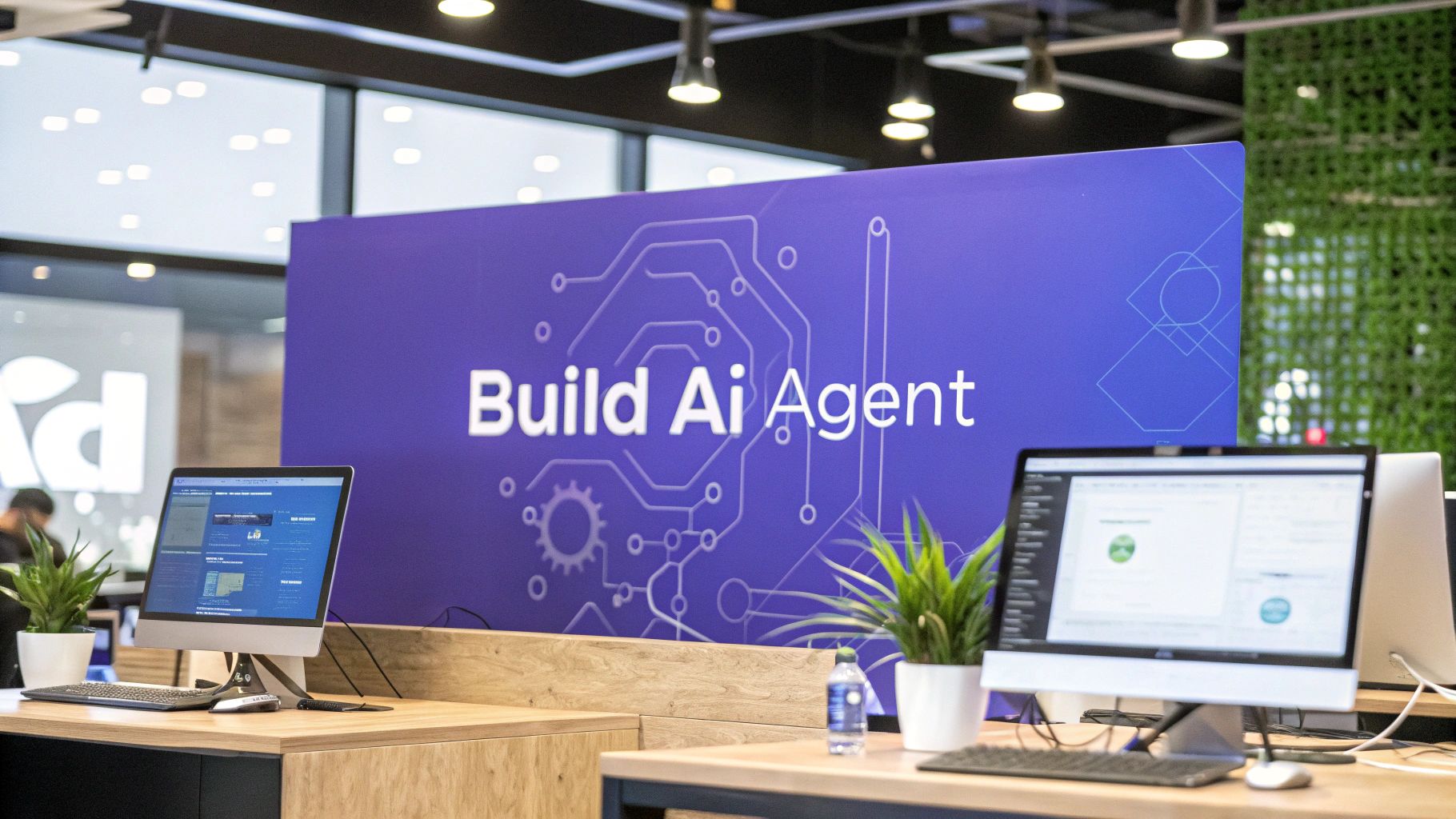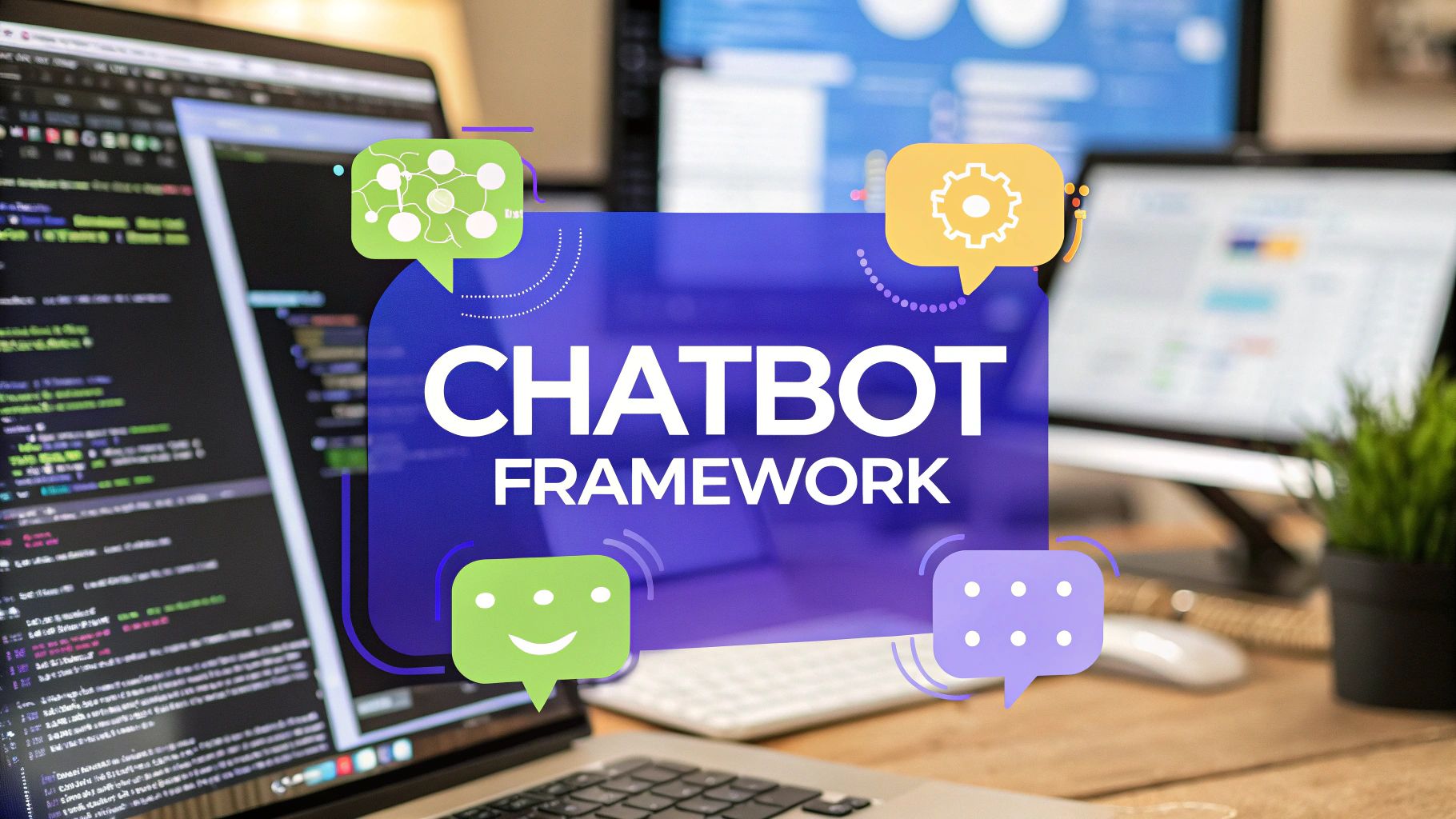8 Chat Bot Best Practices for Success in 2025
Discover the top 8 chat bot best practices for 2025. Learn to design, deploy, and optimize high-performing AI chatbots with our expert guide.
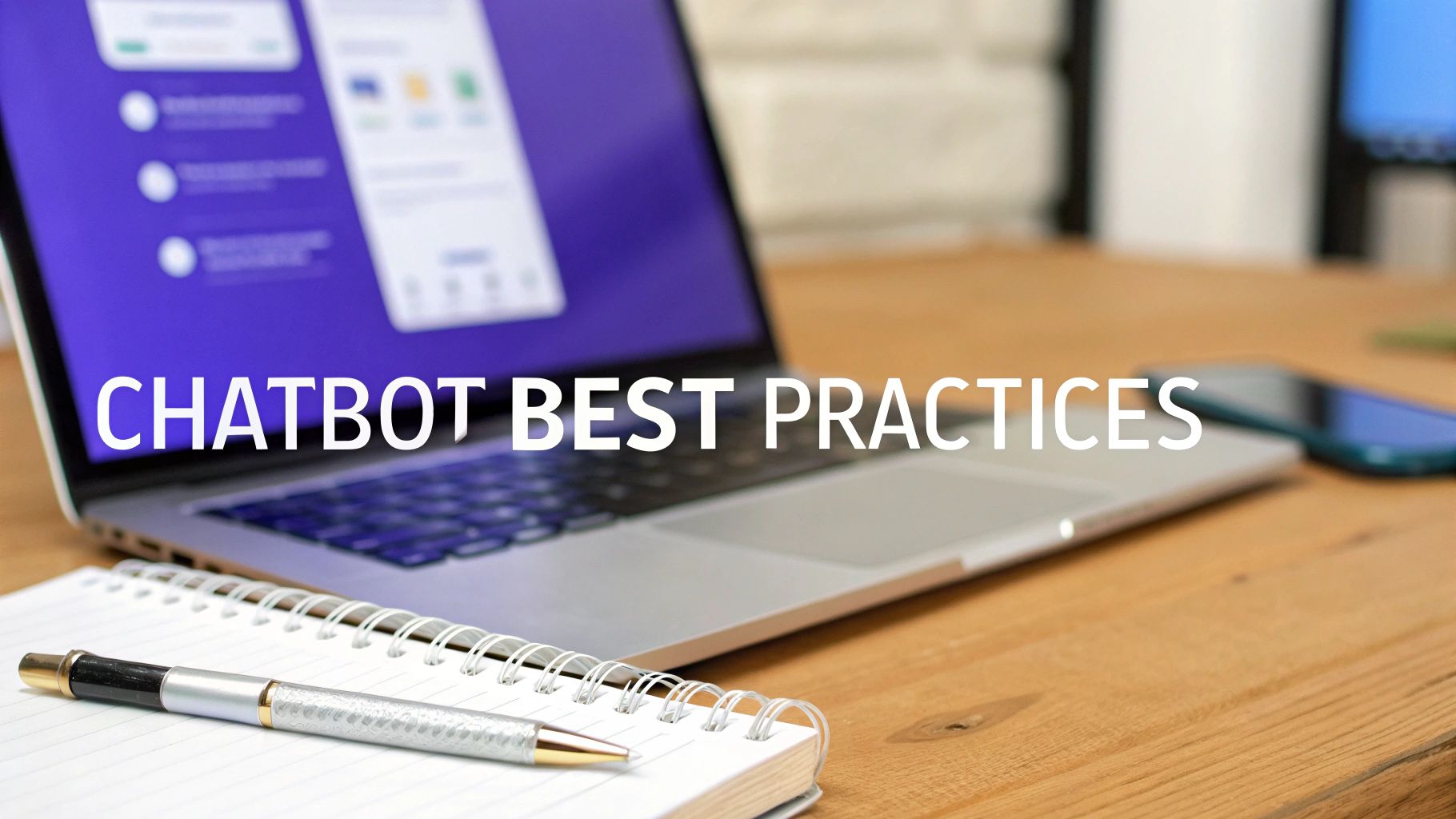
In 2025, a chatbot is no longer a novelty but a core component of digital strategy. Yet, the gap between a frustrating bot and a helpful AI agent is vast, defined by a set of critical principles. Simply deploying a chatbot isn't enough; success hinges on thoughtful design, strategic implementation, and continuous optimization. This guide moves beyond generic advice to provide a comprehensive roundup of actionable chat bot best practices.
We will explore eight essential strategies that transform a basic bot into a powerful asset for your business. For businesses using platforms like Chatiant to create custom AI agents trained on their own data, mastering these practices is the key to unlocking true conversational power. Whether your bot is on your website, in Google Chat, or integrated with platforms like Webflow and WordPress, these insights are crucial.
This blueprint will equip your sales, operations, and customer success teams with the knowledge to build better AI experiences. Let's delve into the techniques that will make your chatbot not just functional, but exceptional, ensuring it drives efficiency and customer satisfaction.
1. Define Clear Purpose and Scope
Before writing a single line of code or designing any conversation flow, the most critical step is to define a precise purpose and narrow scope for your chatbot. Attempting to build a bot that does everything for everyone is a guaranteed path to failure. A clearly defined purpose ensures your chatbot excels at its designated tasks, leading to higher user satisfaction and better business outcomes. This foundational step is a cornerstone of effective chat bot best practices.

This process involves identifying the specific, high-value problem you want to solve. Instead of a generic "customer service bot," define its purpose as "a bot that helps users track their order status and initiate a return." This specificity informs every subsequent decision, from the conversation design to the necessary integrations.
Why It's a Top Practice
A narrow scope prevents user frustration. When a user understands a bot's specific function, like Domino's pizza ordering bot, they have clear expectations and are less likely to ask questions outside its capability. This focus allows you to dedicate resources to perfecting a core experience rather than spreading them thinly across many mediocre functions. It’s the principle of doing one thing exceptionally well.
"A chatbot without a clear purpose is like a ship without a rudder. It might float, but it won't get anywhere useful. The most successful bots, from Bank of America's Erica to Sephora's Virtual Artist, are masters of a specific domain."
Actionable Implementation Tips
- Start with a Single, High-Impact Use Case: Identify the most frequent and repetitive query your support or sales team handles. Automating this one task first provides immediate ROI and a clear performance benchmark.
- Document Everything: Create a scope document that explicitly lists what the bot will do and, just as importantly, what it will not do. Share this with all stakeholders to align expectations early.
- Validate with User Research: Don't assume you know what users want. Conduct surveys or interviews with your target audience to confirm that your chosen use case genuinely addresses their needs.
- Plan for Phased Expansion: While you start small, create a long-term roadmap. Once the initial version is successful, you can strategically add new, related capabilities based on user feedback and data analytics.
2. Design Conversational Flow and User Journey
Once your chatbot’s purpose is defined, the next step is to design the conversational flow. This is the art and science of mapping out the user's journey from their initial query to a successful resolution. A well-designed flow ensures interactions feel intuitive, natural, and efficient, guiding users seamlessly without causing confusion or frustration. This practice is fundamental to creating a positive user experience and is a core element of chat bot best practices.
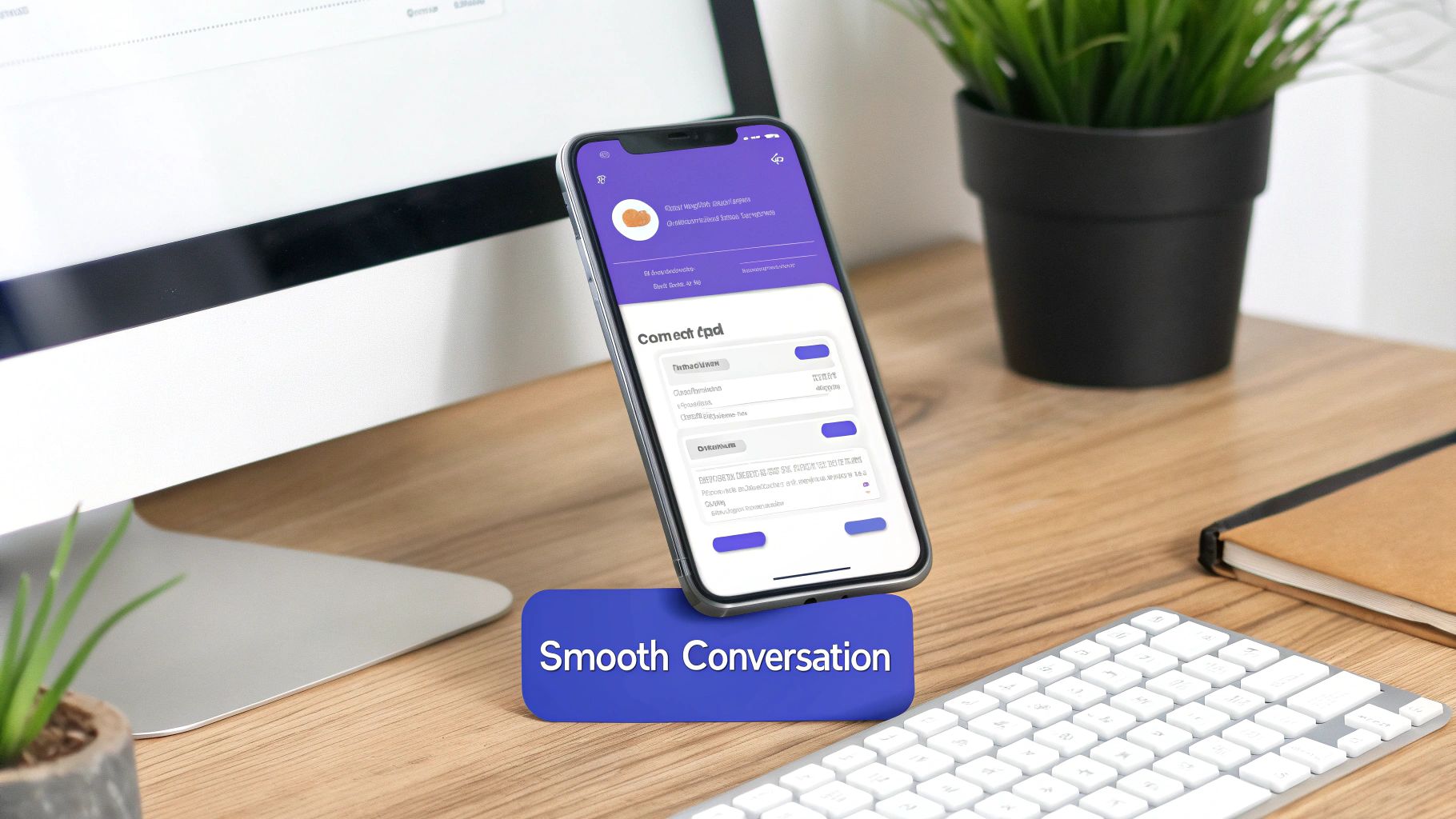
The process involves creating conversation trees and user journey maps that anticipate user needs and potential detours. Think of it as creating a script for a play where the user is the main character. You must plan for every line and every possible response to keep the story moving forward. Great examples include Uber's ride-booking sequence or Capital One's Eno bot, which masterfully guide users through specific financial tasks.
Why It's a Top Practice
A poorly designed conversation is the fastest way to make a user abandon your bot. Without a clear path, users get lost, repeat themselves, or hit dead ends. A strong conversational design, however, builds trust and confidence. It makes the technology feel helpful rather than obstructive, ensuring users can achieve their goals quickly and efficiently, which directly translates to higher engagement and satisfaction rates.
"Conversation is more than just words; it's about structure and intent. The best chatbots don't just respond, they guide. Pioneers like Cathy Pearl and Erika Hall have taught us that a great bot interaction is designed, not improvised. It respects the user's time and intelligence."
Actionable Implementation Tips
- Map Both Happy and Unhappy Paths: Use a visual tool like a flowchart to map the ideal user journey (the "happy path"). Crucially, also map out error scenarios, repair flows for when the bot misunderstands, and escalation paths to a human agent.
- Keep It Concise and Goal-Oriented: Each turn in the conversation should have a clear purpose. Avoid long, rambling messages and get straight to the point. Use buttons and quick replies to make progression effortless for the user.
- Prototype and Test Relentlessly: Don't wait until development is complete. Use simple prototyping tools to test your conversation flows with real users early and often. Their feedback is invaluable for refining the user experience before you write any code. For a deeper dive, you can learn more about crafting effective conversation flows on our blog.
- Provide Clear Next Steps: Never leave a user hanging. At every stage of the conversation, ensure the user knows what to do next or what options are available to them.
3. Implement Robust Natural Language Understanding (NLU)
At the heart of any intelligent chatbot is its ability to comprehend human language. Implementing robust Natural Language Understanding (NLU) is what separates a frustrating, rigid bot from a helpful, conversational one. NLU enables your chatbot to accurately interpret user inputs, understand their underlying intent, and extract key pieces of information (entities). This is a foundational pillar of modern chat bot best practices.
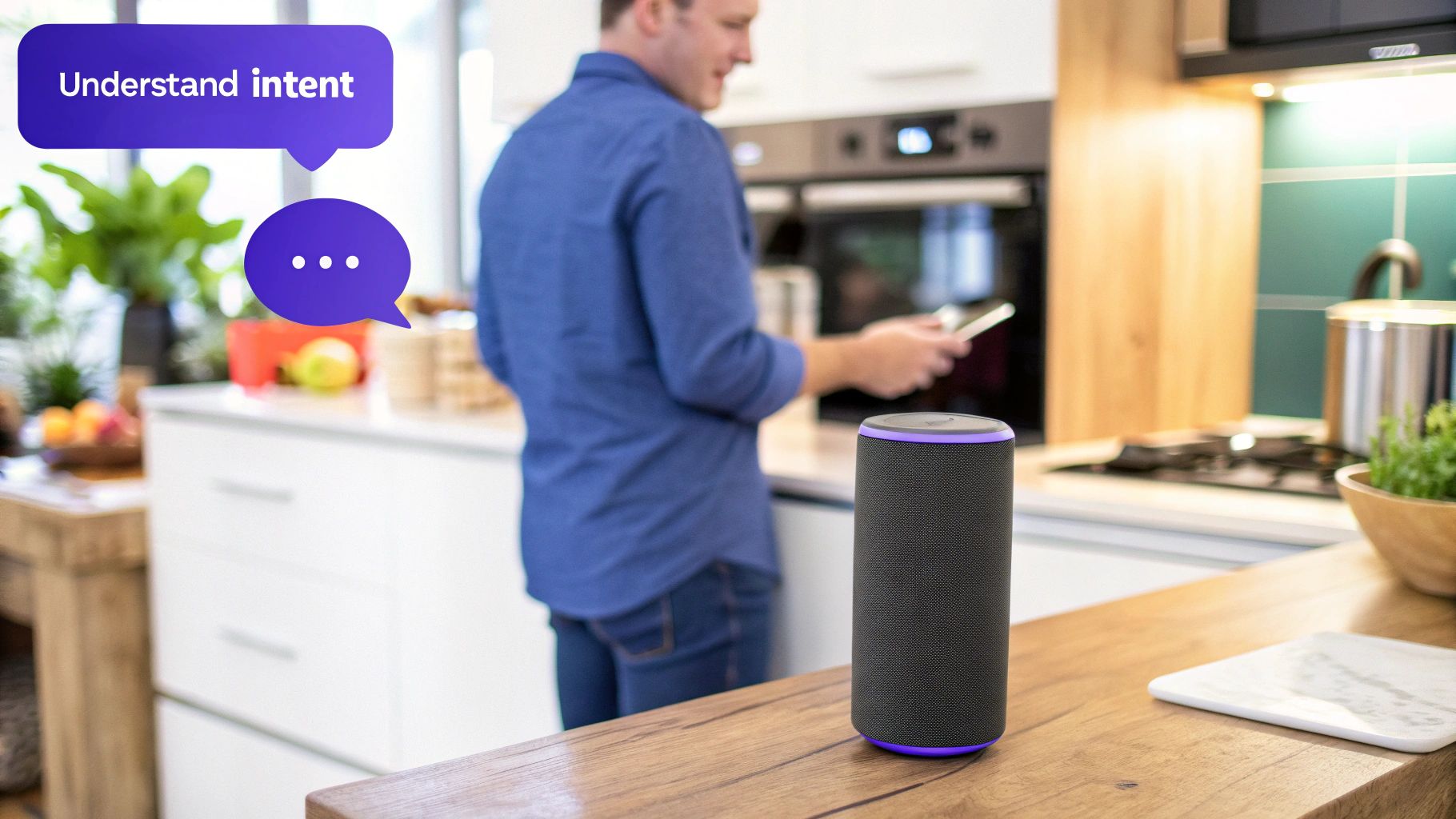
This capability allows a bot to understand "I need to change my flight from NYC to LA for tomorrow" just as easily as "update booking to Los Angeles for tomorrow from New York." Instead of relying on exact keyword matching, a strong NLU model grasps the user's goal (intent: change_flight) and identifies the critical details (entities: NYC, LA, tomorrow).
Why It's a Top Practice
A powerful NLU engine is non-negotiable for creating a natural and effective user experience. It allows for flexible, human-like conversations, reducing the need for users to learn specific commands. When a chatbot correctly understands varied phrasing, slang, and even misspellings, user trust and engagement skyrocket. This is evident in sophisticated systems like Google Assistant and Amazon Alexa, which can process a vast range of spoken and typed commands with remarkable accuracy.
"NLU is the brain of your chatbot. Without a well-trained one, you're just building a glorified interactive FAQ. Investing in quality training data and continuous model improvement is the single most impactful thing you can do for your bot's performance."
Actionable Implementation Tips
- Use Diverse Training Data: Train your NLU model with a wide variety of real-world phrases, not just the "perfect" examples. Include different sentence structures, synonyms, and common typos.
- Implement Confidence Scoring: Configure your bot to trigger a human handoff or ask for clarification when its confidence in understanding an intent falls below a certain threshold (e.g., 75%).
- Regularly Retrain Your Model: Continuously analyze misunderstood queries from your logs. Use this valuable data to retrain and refine your NLU model, making it smarter with every interaction.
- Handle Ambiguity Gracefully: When a user's input is ambiguous, design a flow that asks clarifying questions. For example, if a user says "book a ticket," the bot should ask, "For a flight, train, or event?" You can learn more about integrating advanced NLU capabilities through a chatbot API to build these sophisticated flows.
4. Provide Graceful Error Handling and Fallbacks
No chatbot is perfect; it will inevitably encounter questions it doesn't understand or face a system error. The difference between a good bot and a bad one is how it handles these moments of failure. Implementing effective error handling and fallback mechanisms ensures the conversation doesn't hit a dead end, preventing user frustration and maintaining a positive experience. This is one of the most crucial chat bot best practices for building trust and resilience.

Graceful error handling means the bot acknowledges its limitation in a helpful way and provides a clear path forward. Instead of a blunt "I don't understand," a well-designed bot might say, "I'm not sure I follow. Can you rephrase that? You can also ask me about [topic A], [topic B], or connect with a support agent." This approach keeps the user in control and guides them toward a successful resolution.
Why It's a Top Practice
A conversation breakdown is the fastest way to lose a user. When a bot fails without a recovery plan, it breaks the user's trust and makes them unlikely to engage again. Effective fallbacks, like the seamless agent handoff in Zendesk's Answer Bot or Intercom's fallback system, transform a potential failure into a helpful interaction. This resilience is what distinguishes a professional, enterprise-grade chatbot from a frustrating novelty.
"Your chatbot will fail. How it fails determines its success. A graceful fallback is not an admission of weakness; it's a demonstration of a user-centric design that respects the user's time and effort."
Actionable Implementation Tips
- Design Tiered Fallback Responses: Create multiple levels of error messages. The first time the bot fails, it might ask the user to rephrase. The second time, it could offer a menu of its primary functions. On the third failure, it should proactively offer to connect the user to a human agent.
- Provide a Clear Escalation Path: Always give users an easy and obvious way to reach a human. Phrases like "Talk to an agent" or "Get human help" should be recognized commands that trigger a handoff process without forcing the user through multiple failed attempts.
- Use Empathetic and Helpful Language: Avoid robotic and cold error messages. Use phrases like, "I'm still learning, and I couldn't quite get that," which humanizes the bot and reduces user frustration. Always offer a next step.
- Monitor Fallback Triggers: Regularly analyze logs to see where and why your bot is failing. High fallback rates on a specific topic are a clear signal that you need to improve your bot's training data or build a new conversational flow for that query.
5. Ensure Consistent Brand Voice and Personality
A chatbot is often the first point of contact a customer has with your brand, making its personality a critical extension of your brand identity. Developing a consistent voice and personality helps create a cohesive, memorable user experience that aligns with your overall messaging. This involves defining specific traits, a tone, and a communication style that reflect your brand values and resonate with your target audience. This practice transforms a functional tool into an engaging brand ambassador and is a core component of advanced chat bot best practices.
The goal is to move beyond generic, robotic responses. Whether your brand is playful, professional, empathetic, or motivational, your chatbot’s language should embody that. For instance, Mailchimp's friendly and helpful "Freddie" persona perfectly matches its quirky, user-centric brand, while a financial institution's bot would adopt a more formal, trustworthy, and reassuring tone.
Why It's a Top Practice
A well-defined personality makes interactions more engaging and less transactional. It builds brand affinity and trust, making users feel like they are interacting with a representative of your company, not just a piece of software. This consistency across all touchpoints strengthens brand recall and fosters a more positive perception. When a bot’s personality is misaligned, it can create a jarring experience that undermines brand credibility.
"Your chatbot isn't just a utility; it's a character representing your brand. A strong, consistent personality can turn a simple query into a delightful interaction, building emotional connection and loyalty. It’s the difference between a tool and a trusted assistant."
Actionable Implementation Tips
- Create a Personality Guide: Document the chatbot's persona in detail. Define its core traits (e.g., helpful, witty, formal), vocabulary (words to use and avoid), and even its sense of humor. Share this guide with all developers, designers, and content creators.
- Test for Consistency: Run the chatbot through various scenarios, from simple FAQs to complex error handling, to ensure its personality remains consistent. How does it respond to frustration? How does it deliver good news?
- Gather User Feedback: Use short surveys to ask users about their perception of the bot. Questions like "How would you describe the chatbot's personality?" can provide invaluable insights into whether your intended voice is coming across effectively.
- Evolve Based on Data: Your bot's personality shouldn't be static. Analyze user interactions and feedback to identify areas for improvement. Evolve the persona over time to better meet user expectations and align with your brand's growth.
6. Implement Comprehensive Analytics and Monitoring
Launching a chatbot without a robust analytics and monitoring system is like navigating without a map. To move beyond a basic tool and create a truly effective one, you must track performance, understand user interactions, and identify areas for improvement. Implementing comprehensive analytics is a non-negotiable step that transforms your bot from a static script into a dynamic, learning asset. This data-driven approach is a core pillar of modern chat bot best practices.
This practice involves setting up systems to capture key metrics, analyze conversation logs, and visualize user journeys. Platforms like Dashbot or Botanalytics provide specialized tools for this, helping you measure everything from user engagement and retention to conversation failures and goal completion rates. This granular insight allows you to pinpoint exactly where users struggle and what features they value most.
Why It's a Top Practice
Data provides the objective truth about your chatbot's performance. Instead of guessing why users are dropping off, you can see the exact point in the conversation where they get stuck. This continuous feedback loop is essential for iterative optimization, allowing you to refine conversational flows, improve NLP accuracy, and enhance the overall user experience based on real behavior, not assumptions.
"Data is the lifeblood of a great chatbot. Without it, you're flying blind. Analytics turns guesswork into a clear, actionable roadmap for improvement, ensuring your bot evolves to meet user needs effectively."
Actionable Implementation Tips
- Define KPIs Before Launch: Establish your key performance indicators (KPIs) from the start. These could include goal completion rate, user satisfaction score (CSAT), containment rate (how many queries are solved without human help), and fallback rate (how often the bot fails).
- Analyze Conversation Logs: Regularly review transcripts of conversations, especially those that failed or were handed off to a human agent. This qualitative analysis uncovers misunderstood intents, awkward phrasing, and opportunities to add new knowledge.
- Set Up Automated Alerts: Configure alerts for critical metric drops, such as a sudden spike in the fallback rate or a dip in user satisfaction. This enables you to proactively address issues before they impact a large number of users.
- Use A/B Testing for Optimization: Test different conversation flows, button copy, or welcome messages. Use analytics to measure which version performs better against your KPIs, allowing for data-backed enhancements.
7. Prioritize Security and Privacy Protection
In an era of heightened data sensitivity, a chatbot’s ability to protect user information is not a feature; it's a fundamental requirement. Prioritizing robust security and privacy from day one is essential for building user trust, ensuring regulatory compliance, and protecting your brand's reputation. This involves securing data in transit and at rest, being transparent about data usage, and designing your bot to comply with global privacy laws like GDPR and CCPA. Overlooking this is one of the fastest ways to erode user confidence, making it a critical component of chat bot best practices.
This practice means integrating security into every stage of the chatbot development lifecycle. From the initial design to deployment and ongoing maintenance, every decision should be viewed through a security lens. This includes everything from encrypting conversations to implementing strict access controls for any personally identifiable information (PII) the bot handles.
Why It's a Top Practice
A single data breach can have devastating consequences, including hefty fines, legal action, and irreparable damage to customer loyalty. Users are increasingly aware of their data rights and are hesitant to engage with platforms that seem insecure. When a bot handles sensitive information, like in banking or healthcare, demonstrating enterprise-grade security is non-negotiable. Proactive privacy measures show respect for your users and position your organization as a trustworthy entity.
"User trust is the currency of the digital age. A chatbot that leaks personal data isn't just a technical failure; it's a breach of that trust. The best bots are built on a foundation of security, ensuring every interaction is protected and private."
Actionable Implementation Tips
- Implement Privacy by Design: Build privacy considerations directly into your bot's architecture. This means minimizing data collection to only what is absolutely essential for the bot's function. Don’t ask for an email address if you don't need it.
- Provide Clear Privacy Policies: Make your privacy policy easily accessible within the chat interface. Use plain language to explain what data is collected, why it's collected, and how it is stored and used.
- Use End-to-End Encryption (E2EE): Ensure all communication between the user and the chatbot, as well as between the chatbot and your backend systems, is fully encrypted to prevent eavesdropping.
- Conduct Regular Security Audits: Proactively look for vulnerabilities. Perform regular penetration testing and security audits on your chatbot and its underlying infrastructure to identify and patch weaknesses before they can be exploited.
8. Enable Seamless Human Handoff
No chatbot can handle every query, and pretending it can is a recipe for user frustration. A critical best practice is designing a graceful and seamless handoff process from the bot to a human agent. When a conversation exceeds the bot's capabilities, the transition should be smooth, preserving context and managing user expectations. This hybrid approach ensures that simple queries are resolved efficiently through automation while complex issues receive the expert attention they require, a key component of effective chat bot best practices.
This process involves more than just a button that says "talk to an agent." It requires defining clear escalation triggers, routing the user to the correct department, and transferring the full conversation history. Platforms like Zendesk and Salesforce Service Cloud excel at this, ensuring the human agent has all the necessary information to pick up the conversation without asking the user to repeat themselves.
Why It's a Top Practice
A seamless handoff prevents the number one cause of chatbot abandonment: frustration. When a user is stuck in a loop or the bot misunderstands a complex request, the ability to quickly reach a human turns a negative experience into a positive, supportive one. It shows the user that you value their time and are committed to resolving their issue, blending the efficiency of automation with the empathy of human support.
"The goal of a chatbot isn't to replace humans, but to augment them. The most intelligent systems know their own limits. A smooth handoff is the ultimate sign of a well-designed, user-centric bot that understands when it's time to let a person take over."
Actionable Implementation Tips
- Define Clear Escalation Triggers: Program the bot to escalate automatically after a certain number of failed attempts, upon detection of negative sentiment (e.g., words like "frustrated" or "useless"), or when specific keywords like "speak to a human" are used.
- Preserve Full Conversation Context: Ensure the entire chat history, including any information the user has already provided (like name, order number, or issue description), is transferred to the human agent. This eliminates the dreaded "Can you explain your problem again?" question.
- Train Agents on Bot-Initiated Conversations: Prepare your support team to receive conversations from the chatbot. They should be trained to quickly review the bot transcript and understand the context before engaging with the customer.
- Set Clear Expectations for Wait Times: If an agent is not immediately available, the bot should inform the user of the expected wait time or offer to create a support ticket for a callback. For more information on this, explore our guide on help desk automation.
Best Practices Comparison: 8 Key Chatbot Elements
From Blueprint to Brilliance: Activating Your Chatbot Strategy
Navigating the landscape of chatbot development can seem complex, but the journey from initial concept to a high-performing AI assistant is built upon a foundation of clear, actionable principles. The eight core pillars we've explored provide a comprehensive blueprint for success. From the strategic necessity of defining a clear purpose and meticulously designing conversational flows, to the technical precision of implementing robust NLU and graceful error handling, each practice is a vital component of a greater whole. These aren't just suggestions; they are the essential building blocks for creating experiences that users trust and value.
The most impactful chatbots are never truly "finished." Instead, they are dynamic assets that evolve. This is where the principles of comprehensive analytics, ensuring a consistent brand personality, and prioritizing security and privacy move from theory to daily practice. A well-designed bot becomes an extension of your brand, a reliable first point of contact that builds confidence. By implementing these chat bot best practices, you transform a simple tool into a sophisticated, strategic asset that actively contributes to your business goals.
The Shift from Functional to Exceptional
Adhering to these guidelines creates a significant shift. Your chatbot stops being merely functional-a machine that answers questions-and becomes truly exceptional. An exceptional chatbot understands context, anticipates user needs, and reflects your brand's unique voice, turning potentially frustrating interactions into positive, memorable ones. This distinction is crucial for driving tangible results, whether your goal is boosting sales conversions, improving customer satisfaction scores, or increasing operational efficiency.
The ultimate measure of success is a bot that feels less like a bot and more like a helpful, intelligent partner. This is achieved when a seamless human handoff is not an afterthought but an integrated part of the user journey, ensuring that no customer is ever left at a dead end. Mastering this ecosystem of best practices is what separates a basic Q&A widget from a powerful conversational AI that delivers measurable ROI and enhances your brand's reputation.
Your Actionable Path Forward
The path to building a brilliant chatbot begins with a commitment to these core principles. Start by auditing your current or planned chatbot against the eight best practices discussed.
- Identify: Pinpoint the areas where you can make the most immediate impact. Is your error handling generic? Is your brand voice inconsistent?
- Prioritize: Select one or two key areas, such as improving your analytics framework or refining your human handoff protocol, and focus your efforts there first.
- Iterate: Use the data and user feedback you gather to continuously refine and optimize every aspect of the conversation, from the initial greeting to the final resolution.
By consistently applying and refining these chat bot best practices, you are not just building a piece of software. You are investing in a smarter, more efficient way to engage with your audience, solve their problems, and grow your business.
Ready to put these best practices into action with a platform built for excellence? Chatiant provides the powerful tools you need to design, deploy, and optimize sophisticated chatbots that deliver real results. Explore how Chatiant can help you build your next-generation AI assistant today.
